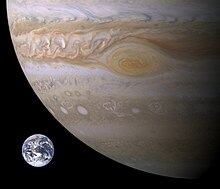Jupiter radius
| Jupiter radius | |
|---|---|
 The size of Jupiter compared to Earth | |
| General information | |
| Unit system | astronomy |
| Unit of | length |
| Symbol | RJ, RJup,R♃ |
| Conversions | |
| 1 RJ in ... | ... is equal to ... |
| SI base units | 7.1492×107 m[1] |
| English units | 44423 miles |
Jupiter radius or Jovian radius (RJ or RJup) is the distance equal to the radius of planet Jupiter. It has a value of 71,492 km (44,423 mi), or 11.2 Earth radii (R🜨)[2] (one Earth radius equals 0.08921 RJ). Jupiter radius is a unit of length used in astronomy to describe the radii of gas giants and some extrasolar planets. It is also used in describing brown dwarfs.
In 2015, the International Astronomical Union defined the nominal equatorial Jovian radius to remain constant regardless of subsequent improvements in measurement precision of RJ. This constant is defined as exactly:
- = 7.1492×107 m
Similarly, the nominal polar Jovian radius is defined to be exactly:
- = 6.6854×107 m[1]
These values correspond to the radius of Jupiter at 1 bar of pressure. The common usage is to refer to the equatorial radius, unless the polar radius is specifically needed.
Comparison
| Object | RJ / Robject | Ref |
|---|---|---|
| Lunar radius | 41 | |
| Earth radius | 11.209 | [2] |
| Jupiter | 1 | by definition |
| Solar radius | 0.10045 |
For comparison, one Solar radius is equivalent to:
- 400 Lunar radius(RL)
- 109 Earth radius (R🜨)
- 9.735 Jupiter radius (RJ)
References
- ^ a b Mamajek, E. E; Prsa, A; Torres, G; et al. (2015). "IAU 2015 Resolution B3 on Recommended Nominal Conversion Constants for Selected Solar and Planetary Properties". arXiv:1510.07674 [astro-ph.SR].
- ^ a b Williams, Dr. David R. (2 November 2007). "Jupiter Fact Sheet". NASA. Retrieved 2009-07-16.



